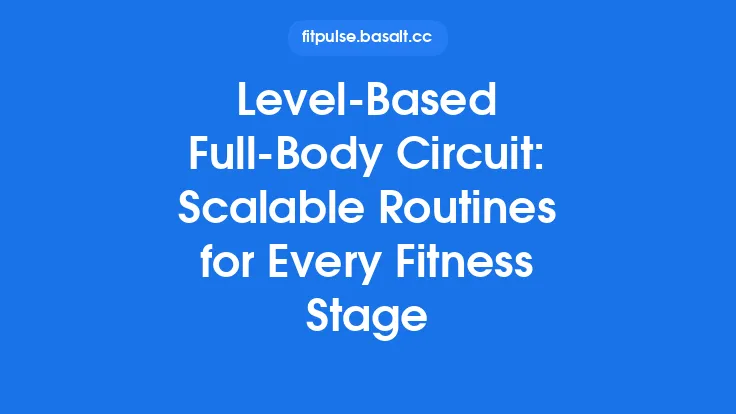When you step into a park and see the familiar silhouettes of pull‑up bars, parallel bars, benches, and open ground, you’re looking at a ready‑made gym that can deliver a complete, balanced workout without a single machine. The key to turning that space into an effective full‑body calisthenics circuit lies in thoughtful exercise selection, logical sequencing, and purposeful progression. By treating the park as a modular training environment, you can craft a routine that simultaneously develops strength, power, endurance, flexibility, and coordination—exactly the blend needed for functional fitness and long‑term health.
Understanding the Principles of a Balanced Circuit
A balanced circuit is more than a random collection of moves; it follows a set of physiological and biomechanical principles that ensure every major muscle group receives adequate stimulus while minimizing overuse.
| Principle | What It Means for Your Circuit | Practical Implication |
|---|---|---|
| Reciprocal Muscle Activation | Pair agonist‑antagonist actions (e.g., push vs. pull, hip extension vs. flexion) to promote joint stability and prevent muscular imbalances. | Follow a push exercise (push‑up) with a pull exercise (inverted row). |
| Vertical Plane Coverage | Include movements that load the body in the sagittal, frontal, and transverse planes. | Add lateral lunges (frontal) and rotational woodchops (transverse) alongside standard squats. |
| Load Distribution | Spread high‑intensity, high‑load exercises throughout the circuit rather than clustering them, which helps maintain technique under fatigue. | Alternate a demanding plyometric jump with a controlled static hold. |
| Time Under Tension (TUT) | Manipulate tempo to target different fiber types; slower eccentrics build strength, faster concentric phases develop power. | Perform a 3‑second descent on a dip, then explode upward. |
| Rest‑to‑Work Ratio | Adjust rest intervals to match the desired training focus: shorter rests (30‑45 s) for conditioning, longer rests (90‑120 s) for maximal strength. | Use a 60‑second rest after a set of pistol squats if strength is the priority. |
By embedding these concepts into the circuit blueprint, you guarantee a holistic stimulus that translates to real‑world performance.
Key Exercise Categories for Full‑Body Development
A truly balanced park circuit should draw from six core categories. Each category addresses a distinct functional domain, and together they create a synergistic whole.
- Vertical Push – Develops shoulder stability, triceps strength, and upper‑body pressing power.
Examples: Handstand push‑ups (advanced), pike push‑ups, elevated shoulder taps.
- Horizontal Pull – Targets the mid‑back, biceps, and scapular retractors.
Examples: Inverted rows on low bars, body‑weight rows using a sturdy fence, towel rows on a rail.
- Hip Dominant Lower‑Body – Emphasizes glutes, hamstrings, and posterior chain power.
Examples: Single‑leg Romanian deadlifts (body‑weight), glute bridges on a bench, reverse Nordic curls.
- Knee Dominant Lower‑Body – Focuses on quadriceps, knee stability, and overall leg endurance.
Examples: Bulgarian split squats on a bench, jump squats, step‑ups with a high platform.
- Core Anti‑Extension/Anti‑Rotation – Strengthens the deep stabilizers that protect the spine during dynamic movement.
Examples: Hollow body holds, side planks with leg lifts, windshield wipers on a low bar.
- Dynamic Conditioning – Elevates heart rate, improves metabolic capacity, and reinforces movement patterns under fatigue.
Examples: Burpees, bear crawls, sprint intervals between stations.
When you allocate at least one exercise from each category per circuit, you guarantee comprehensive muscular engagement and functional transfer.
Designing the Circuit Structure: Sets, Reps, and Timing
The architecture of a circuit determines its training effect. Below is a step‑by‑step framework for constructing a balanced session.
- Determine the Primary Goal
- Strength/Power: 3–5 rounds, 4–6 reps per exercise, 90–120 s rest between rounds.
- Hypertrophy/Endurance: 4–6 rounds, 8–12 reps, 60–90 s rest.
- Conditioning: 5–8 rounds, 30–45 s work per station, 15–30 s transition.
- Select Exercise Order
- Begin with the most technically demanding or heaviest load (e.g., pistol squat).
- Follow with a complementary movement (e.g., inverted row).
- Insert a conditioning burst (e.g., 30 s of high‑knees) to keep heart rate elevated.
- End with a core stabilizer (e.g., hollow hold) to reinforce postural control.
- Set Work‑to‑Rest Ratios
- Strength Focus: 1:2–1:3 (e.g., 45 s work, 90 s rest).
- Conditioning Focus: 1:0.5 (e.g., 30 s work, 15 s rest).
- Adjust based on individual recovery capacity and environmental factors (e.g., temperature).
- Incorporate Tempo Manipulation
- Use a 4‑2‑1 tempo for strength (4 s eccentric, 2 s pause, 1 s concentric).
- Switch to explosive tempo for power moves (e.g., jump squat).
- Keep a consistent tempo within a round to avoid inadvertent fatigue spikes.
- Plan Transition Mechanics
- Define a clear “station” layout to minimize wasted movement.
- Use a “ready‑set‑go” cue to synchronize start times across participants if training in a group.
By systematically applying these parameters, you can tailor the circuit to any training objective while preserving balance across muscle groups.
Progression Strategies to Keep Advancing
Stagnation is the enemy of long‑term development. The park environment offers numerous avenues for progressive overload without added equipment.
| Progression Type | How to Apply in a Circuit |
|---|---|
| Load Increase | Add a weighted vest, backpack, or ankle weights. |
| Range of Motion (ROM) Expansion | Move from a standard push‑up to a deep push‑up on parallel bars, then to a handstand push‑up. |
| Tempo Modification | Slow the eccentric phase (e.g., 5 s descent) or add a pause at the bottom. |
| Repetition Scheme | Increase reps per set or add an extra set per round. |
| Complexity Upgrade | Combine two movements into a single fluid transition (e.g., squat‑to‑pull‑up). |
| Unstable Surfaces | Perform single‑leg variations on a low bench or use a balance beam for core work. |
| Reduced Rest | Shorten the rest interval by 10–15 s each week. |
A practical progression plan might look like this:
- Weeks 1‑2: Baseline circuit with body‑weight only, 8 reps per exercise, 60 s rest.
- Weeks 3‑4: Add a 5 lb backpack, increase to 10 reps, keep rest.
- Weeks 5‑6: Introduce a 3‑second pause at the bottom of each push‑up, reduce rest to 45 s.
- Weeks 7‑8: Replace standard rows with feet‑elevated rows, add a plyometric element (e.g., jump lunges).
Documenting these variables in a training log ensures you can objectively assess progress and adjust the stimulus as needed.
Scaling Options for Different Skill Levels
A balanced circuit should be inclusive. Below are scaling guidelines that preserve the intended stimulus while accommodating varying abilities.
| Exercise | Beginner Modification | Intermediate Version | Advanced Variation |
|---|---|---|---|
| Pike Push‑Up | Incline push‑up on a bench (hands elevated) | Standard pike push‑up | Handstand push‑up against a wall |
| Inverted Row | Row with feet on the ground, bar low | Feet elevated on a step | Feet on a higher platform, weighted vest |
| Bulgarian Split Squat | Split squat with rear foot on the ground | Rear foot on a low bench | Rear foot on a higher bench, add jump |
| Hollow Hold | Bent‑knee hollow (knees flexed) | Straight‑leg hollow | Hollow rock with alternating arm/leg extensions |
| Burpee | Step‑back instead of jump, no push‑up | Standard burpee | Burpee with a tuck jump and handstand at the top |
When programming for a mixed‑ability group, assign each participant to the appropriate variation and keep the work interval consistent across the circuit. This maintains the shared conditioning stimulus while respecting individual strength levels.
Integrating Cardio and Conditioning Elements
A full‑body circuit thrives when cardiovascular demand is woven into the strength sequence. Conditioning stations should complement, not detract from, the primary movement goals.
- High‑Knee Skips – 30 s between lower‑body strength stations to keep lower‑body blood flow active.
- Bear Crawl – 20 m forward and back, reinforcing shoulder stability while raising heart rate.
- Sprint Intervals – 40 m dash after a set of pull‑ups, capitalizing on the primed posterior chain.
- Jump Rope – 45 s of single‑unders after core work, providing a low‑impact cardio burst.
By limiting each conditioning burst to 30‑45 seconds, you avoid excessive fatigue that could compromise form on subsequent strength exercises. Moreover, the brief, high‑intensity bursts stimulate both aerobic and anaerobic pathways, enhancing overall metabolic conditioning.
Sample Balanced Full‑Body Park Circuit
Below is a ready‑to‑use template that embodies the principles discussed. Adjust reps, tempo, and rest to match your specific goal.
| Station | Exercise | Reps / Time | Tempo | Scaling |
|---|---|---|---|---|
| 1 | Pike Push‑Up | 8 reps | 3‑1‑1 | Incline push‑up (beginner) |
| 2 | Bear Crawl | 20 m forward & back | Continuous | Slow crawl for beginners |
| 3 | Inverted Row | 10 reps | 2‑2‑1 | Feet on ground (beginner) |
| 4 | Sprint | 40 m | Max effort | Walk back for recovery |
| 5 | Bulgarian Split Squat (right leg) | 8 reps | 3‑0‑1 | Rear foot on ground |
| 6 | Hollow Hold | 30 s | Static | Bent‑knee hollow (beginner) |
| 7 | Jump Squat | 12 reps | Explosive | Body‑weight squat (beginner) |
| 8 | Side Plank with Leg Lift (left) | 20 s | Static | Regular side plank |
| 9 | Reverse Nordic Curl | 6 reps | 4‑0‑1 | Glute bridge (beginner) |
| 10 | Burpee | 10 reps | Continuous | Step‑back burpee |
Protocol: Complete all ten stations consecutively, then rest 60 seconds. Repeat for 4–5 rounds (strength focus) or 6–8 rounds (conditioning focus). Track total time, quality of movement, and perceived exertion each session.
Tracking Performance and Making Adjustments
Objective data drives meaningful progress. Consider the following metrics:
- Repetition Quality Score (RQS) – Rate each set on a 1‑10 scale based on depth, control, and alignment.
- Circuit Completion Time (CCT) – Record total time for a full round; aim for a 2‑5 % improvement each week.
- Heart Rate Recovery (HRR) – Measure beats per minute drop 60 seconds after the circuit; faster recovery indicates improved conditioning.
- Load Increment Log – Note any added weight (vest, backpack) and the week it was introduced.
Every 4‑6 weeks, review these data points. If CCT plateaus while RQS remains high, consider increasing load or reducing rest. Conversely, if RQS drops sharply, scale back intensity or revisit technique cues.
Common Pitfalls and How to Avoid Them
| Pitfall | Why It Happens | Corrective Action |
|---|---|---|
| Neglecting Opposing Muscle Groups | Focusing on favorite moves (e.g., push‑ups) | Ensure each push is paired with a pull, each squat with a hinge. |
| Excessive Rest Between Stations | Over‑estimating fatigue | Use a timer; keep transitions under 15 seconds. |
| Uniform Tempo Across All Exercises | Convenience over specificity | Apply distinct tempos (slow eccentrics for strength, fast for power). |
| Skipping Core Stabilization | Belief that core is “extra” | Include at least one anti‑extension/rotation move per round. |
| Training in Extreme Heat Without Hydration | Ignoring environmental stress | Schedule sessions early/late, bring water, monitor exertion. |
By proactively addressing these issues, you preserve the integrity of the circuit and reduce the risk of overuse injuries.
Creating a Sustainable Outdoor Calisthenics Routine
A balanced circuit is only as effective as the consistency with which you perform it. To embed park training into your lifestyle:
- Schedule Fixed Sessions – Treat the circuit like a class; block 45‑60 minutes on your calendar.
- Rotate Exercise Variations – Every 4‑6 weeks, swap in a new movement from each category to keep neuromuscular adaptation high.
- Engage the Community – Invite a friend or join a local park group; social accountability boosts adherence.
- Periodize Quarterly – Cycle through phases (strength, hypertrophy, conditioning) to avoid monotony and promote comprehensive development.
- Reflect Weekly – Spend 5 minutes after each session noting what felt strong, what faltered, and any adjustments needed.
When the circuit becomes a predictable, enjoyable part of your week, the benefits—enhanced functional strength, improved cardiovascular health, and a deeper connection to the outdoors—will compound over time.





